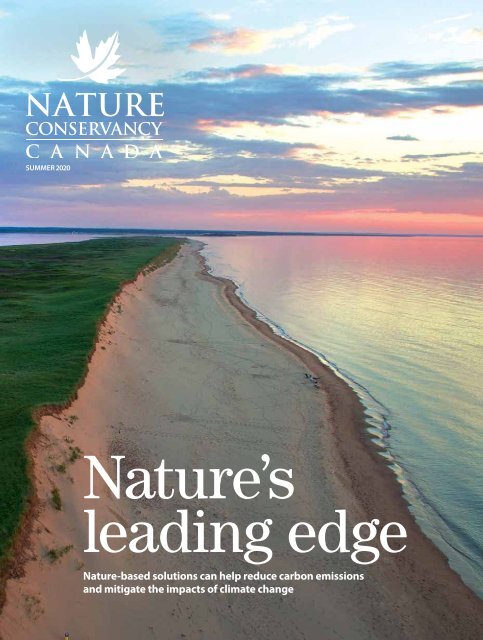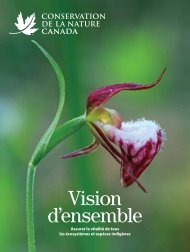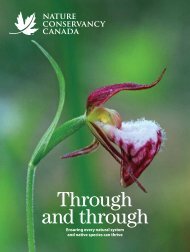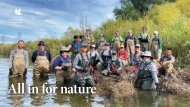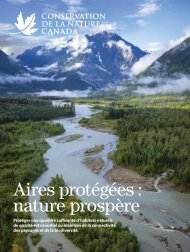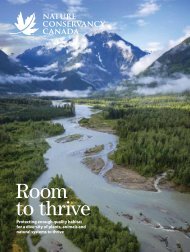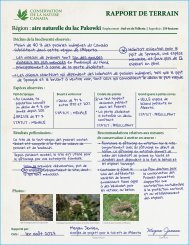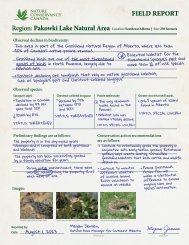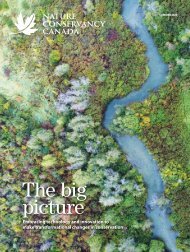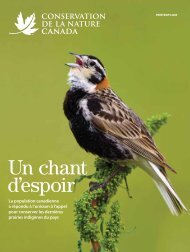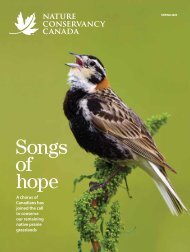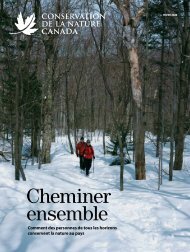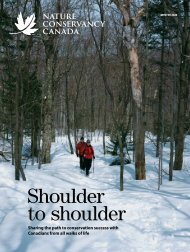NCC-SU20-EN
Create successful ePaper yourself
Turn your PDF publications into a flip-book with our unique Google optimized e-Paper software.
SUMMER 2020<br />
Nature’s<br />
leading edge<br />
Nature-based solutions can help reduce carbon emissions<br />
and mitigate the impacts of climate change
Nature Conservancy of Canada<br />
245 Eglinton Ave. East, Suite 410<br />
Toronto, Ontario, Canada M4P 3J1<br />
magazine@natureconservancy.ca<br />
Phone: 416.932.3202<br />
Toll-free: 877.231.3552<br />
The Nature Conservancy of Canada<br />
(<strong>NCC</strong>) is the nation’s leading land<br />
conservation organization, working<br />
to protect our most important natural<br />
areas and the species they sustain.<br />
Since 1962, <strong>NCC</strong> and its partners have<br />
helped to protect 14 million hectares<br />
(35 million acres), coast to coast to coast.<br />
The Nature Conservancy of Canada<br />
Magazine is distributed to donors and<br />
supporters of <strong>NCC</strong>.<br />
TM<br />
Trademarks owned by The Nature<br />
Conservancy of Canada.<br />
FSC is not responsible<br />
for any calculations on<br />
saving resources by<br />
choosing this paper.<br />
Printed on Rolland Opaque paper,<br />
which contains 30% post-consumer<br />
fibre, is EcoLogo, Processed Chlorine<br />
Free certified and manufactured in<br />
Canada by Rolland using biogas energy.<br />
Printed in Canada with vegetable-based<br />
inks by Warrens Waterless Printing.<br />
This publication saved 29 trees and<br />
104,292 litres of water*.<br />
COVER<br />
Blooming Point, PEI<br />
Photo by Mike Dembeck.<br />
THIS PAGE<br />
Darkwoods Conservation Area<br />
Photo by Steve Ogle.<br />
TKTKTKTKTKTKT<br />
G<strong>EN</strong>ERATED BY: CALCULATEUR.ROLLANDINC.COM.<br />
*<br />
2 WINTER 2020 natureconservancy.ca
SUMMER 2020<br />
CONT<strong>EN</strong>TS<br />
Nature Conservancy of Canada<br />
Dear friends,<br />
8<br />
TKTKTKTKTKTKT<br />
Many of us have had our lives turned upside<br />
down in the past few months. But perhaps nature<br />
has also provided you with little flashes of joy and<br />
a respite from the news.<br />
Despite lockdowns and physical distancing, the<br />
Nature Conservancy of Canada (<strong>NCC</strong>) team has<br />
been working hard to keep our promise to conserve<br />
the natural areas that sustain us all.<br />
This spring, we continued to add conservation<br />
lands to our portfolio. Starting in early May, as<br />
restrictions began to ease in some provinces, some<br />
of our field staff began their summer stewardship<br />
work and we started to reopen our trails. I urge you<br />
to continue to check our website on a regular basis<br />
for updates on access to the natural areas near you.<br />
I want to assure you your gifts remain hard at<br />
work, protecting Canada’s most precious natural<br />
spaces and the species that live there. We will not lose<br />
sight of this vital work, even in these trying times.<br />
Finally, I also want to acknowledge the anger<br />
and sadness brought to the forefront by recent acts<br />
of racism and injustice here in Canada and around<br />
the world. Conservationists cannot remain silent on<br />
systemic racism nor the marginalization of Black,<br />
Indigenous and People of Colour, LGBTQ+ people,<br />
persons with disabilities, and other underrepresented<br />
groups.<br />
At <strong>NCC</strong>, we believe that nature needs to be accessible<br />
to everyone, and recognize that this is not<br />
yet the case. Our values are rooted in a respect for<br />
people and nature. We can and will do more to<br />
amplify voices of minority communities and vulnerable<br />
people in our work and through our influence.<br />
I hope you and your loved ones are safe and look<br />
forward to celebrating nature with you just as soon<br />
as it is safe to do so.<br />
John Lounds<br />
John Lounds<br />
President & CEO<br />
16 4<br />
14 Protecting Canada’s endemic species<br />
These plants and animals are uniquely Canadian; they’re not found<br />
anywhere else in the world.<br />
6 Buffalo Pound<br />
Explore wide open grasslands along a beautiful shoreline in Saskatchewan’s<br />
Qu’Appelle Valley.<br />
7 A pocketful of action<br />
With her Swiss Army Knife in hand, writer and editor Kim Gray is always<br />
ready for adventure and possibility.<br />
8 Nature’s way forward<br />
<strong>NCC</strong>’s Darkwoods property in BC provides a blueprint for how nature-based<br />
solutions can help reduce carbon emissions and mitigate the impacts of<br />
climate change.<br />
12 Gulf of St. Lawrence beach pinweed<br />
The future of this highly specialized beach dune species is threatened by<br />
rising sea levels and coastal development.<br />
14 Project updates<br />
An ever-growing success in New Brunswick; new digital project in Ontario;<br />
improving road safety in Quebec’s Laurentians.<br />
16 Bring nature home<br />
Connect virtually to Canada this summer and become a Force for Nature<br />
from home.<br />
18 Making memories<br />
Family memories made one paddle stroke at a time.<br />
natureconservancy.ca<br />
SUMMER 2020 3
COAST TO<br />
COAST<br />
Ours to save<br />
These plants and animals are uniquely Canadian;<br />
they’re not found anywhere else in the world<br />
Canada has thousands of species of conservation concern. Some are rare<br />
provincially, while others are at risk in the entire country or imperilled<br />
globally. Most have a range that extends beyond our borders and we share<br />
responsibility for their conservation with other countries. But there is a select<br />
group of species that occurs only in Canada, known as nationally endemic species.<br />
To support the conservation of Canada’s endemic species, the Nature<br />
Conservancy of Canada (<strong>NCC</strong>) and NatureServe Canada have developed the<br />
first comprehensive report on this group of uniquely Canadian wildlife. The<br />
report highlights over 300 of Canada’s nationally endemic plants, animals and<br />
insects, and maps hot spots across the country where they can be found.<br />
<strong>NCC</strong> is already helping to protect many of these, including the Gulf of St. Lawrence<br />
aster and Newfoundland marten. But more conservation efforts are needed<br />
to prevent their extinction. In addition to guiding <strong>NCC</strong>’s work, the report will<br />
be an important resource for other groups across Canada. Here are some of the<br />
endemic species from across the country that <strong>NCC</strong> is already helping to protect.<br />
LEARN MORE ABOUT<br />
CANADA’S <strong>EN</strong>DEMIC SPECIES!<br />
natureconservancy.ca/ourstosave<br />
ROBERT MCCAW.<br />
4 SUMMER 2020 natureconservancy.ca
Indicates an example of an <strong>NCC</strong> property or natural area where <strong>NCC</strong> is protecting habitat for this species.<br />
BRITISH COLUMBIA<br />
Pacific Steller’s jay<br />
(carlottae subspecies)<br />
The Steller’s jay, carlottae subspecies, is found<br />
only on Haida Gwaii, where many endemic<br />
species occur, because of its isolation and<br />
ice-free areas that remained during the last<br />
glaciation period. Sometimes called the Pacific<br />
Steller’s jay, this subspecies is larger and darker<br />
than the Steller’s jay found throughout western<br />
North America.<br />
<br />
<strong>NCC</strong> has protected habitat that may be used<br />
by the Steller’s jay, carlottae subspecies, in the<br />
Kumdis River Conservation Area<br />
MANITOBA<br />
Harris’s sparrow<br />
This handsome sparrow is commonly seen at<br />
feeders in the U.S. during the winter, but it is<br />
the only songbird that exclusively breeds in<br />
Canada. Harris’s sparrow nests in open tundra<br />
near thickets. It has been declining in the past<br />
few decades possibly due to habitat loss and<br />
climate change.<br />
NEW BRUNSWICK<br />
Gulf of St. Lawrence aster<br />
The tiny annual plant lives only along the moist<br />
sandy shores and salt marshes of the Gulf of St.<br />
Lawrence and is restricted to just a few sites. Its<br />
numbers can vary greatly each year, depending<br />
on habitat conditions. It is threatened by coastal<br />
development and sea level rise.<br />
Miscou Island<br />
NOVA SCOTIA<br />
Atlantic whitefish<br />
The global range of this critically endangered fish<br />
is now restricted to the Petite Rivière watershed. It<br />
once only entered fresh water to spawn and then<br />
lived in the sea, but these migrations have been<br />
cut off by dams. Invasive species threaten wild<br />
populations, and the Atlantic whitefish’s recovery<br />
will depend on captive breeding.<br />
TOP TO BOTTOM: HARRIS’S SPARROW: ROBERT MCCAW, LAKE LOUISE ARNICA : JE9H/INATURALIST, SALT MARSH COPPER : KMELVILLE/INATURALIST, EASTERN WOLF: ROGGER/INATURALIST, WHOOPING CRANE: ROBERT MCCAW.<br />
ALBERTA<br />
Lake Louise arnica<br />
This globally imperilled yellow wildflower is<br />
found only in the Canadian Rockies of Alberta<br />
and BC. Also known as snow arnica, this species<br />
grows at high elevations on exposed alpine<br />
slopes and rockslides.<br />
<br />
Castle-Crowsnest Watershed Natural Area<br />
SASKATCHEWAN<br />
Whooping crane<br />
The endangered whooping crane was once<br />
down to about 20 birds. Thanks to captive<br />
breeding and habitat protection, there are now<br />
more than 600. There are continued efforts to<br />
establish breeding colonies in the U.S., but the<br />
only self-sustaining wild population nests in<br />
Wood Buffalo National Park.<br />
<br />
Big Valley Complex (during migration only)<br />
<br />
Ellice-Archie Community Pasture, Fish Lake<br />
Drain Parklands (during migration only)<br />
ONTARIO<br />
Eastern wolf<br />
Thousands of people have heard its call at annual<br />
public wolf howls in Algonquin Provincial Park.<br />
The eastern wolf is a complicated species that<br />
hybridizes (crossbreeds) with both larger grey<br />
wolves and smaller eastern coyotes. It once<br />
ranged into the northeastern U.S., but the main<br />
population is now centred within Algonquin Park.<br />
<br />
Loughborough Wilderness Block,<br />
Martha Webber<br />
QUEBEC<br />
Copper redhorse<br />
Copper redhorse can be found only in the St.<br />
Lawrence River and its tributaries in Quebec. This<br />
large fish lives along the marshy edges of islands<br />
and spawns in the Richelieu River. It is threatened<br />
by water pollution, habitat loss and dams.<br />
<br />
Îles du Fleuve Saint-Laurent, Richelieu-Yamaska<br />
<br />
<strong>NCC</strong> has developed a freshwater conservation<br />
blueprint for the region that is supporting<br />
partner-led initiatives for the species’ recovery.<br />
PRINCE EDWARD ISLAND<br />
Salt marsh copper<br />
Also known as maritime copper, this small<br />
butterfly occurs only in salt marshes along the<br />
Gulf of St. Lawrence coasts of Quebec, New<br />
Brunswick, Nova Scotia and PEI. It can be locally<br />
common, especially where sea lavender grows.<br />
Some of its habitat is threatened by coastal<br />
development and rising sea levels.<br />
Percival River<br />
NEWFOUNDLAND AND LABRADOR<br />
American marten<br />
(Newfoundland population)<br />
This unique subspecies of American marten lives<br />
only on the island of Newfoundland. It primarily<br />
eats small mammals, including snowshoe hare.<br />
Once listed as endangered, its numbers have<br />
increased thanks to habitat protection.<br />
The Grasses<br />
natureconservancy.ca<br />
SUMMER 2020 5
BOOTS ON<br />
THE TRAIL<br />
Buffalo Pound Lake provides drinking water<br />
for one-quarter of Saskatchewan’s population.<br />
Buffalo Pound<br />
Explore wide open grasslands along a beautiful shoreline<br />
in Saskatchewan’s Qu’Appelle Valley<br />
Northern leopard frog<br />
There’s a gentle breeze blowing, and<br />
you’re sitting in a patch of native<br />
prairie above the Qu’Appelle Valley,<br />
on a rock that’s still warm from the hot<br />
afternoon sun. You can smell sagebrush and<br />
maybe even the light scent of prairie rose<br />
rising up. You close your eyes, breathe<br />
in the fresh, fragrant air and listen to the<br />
songs of grassland birds. The Nature<br />
Conservancy of Canada’s (<strong>NCC</strong>’s) Buffalo<br />
Pound property in Saskatchewan offers<br />
these vibrant sights and sounds for you<br />
to explore.<br />
Buffalo Pound consists of 866 hectares<br />
(2,140 acres) of native grasslands, which is<br />
one of the most endangered ecosystems in<br />
the world. The property, 40 kilometres from<br />
Moose Jaw, Saskatchewan, includes seven<br />
kilometres along the north shore of Buffalo<br />
Pound Lake.<br />
A RECREATIONAL TREASURE<br />
Buffalo Pound Lake is a cherished recreational<br />
area, valued by young and old alike<br />
as a popular place to hike, bike, swim and<br />
kayak. The lake stores the drinking water<br />
for a quarter of Saskatchewan’s population,<br />
including the cities of Moose Jaw and Regina.<br />
The native grasslands around the lake<br />
help keep this water clean and hold back<br />
flood waters.<br />
JASON BANTLE. INSET: ADOBE STOCK.<br />
6 SUMMER 2020 natureconservancy.ca
BACKPACK<br />
ESS<strong>EN</strong>TIALS<br />
Bobolink<br />
American badger<br />
SPECIES TO SPOT<br />
The property provides habitat for at-risk species,<br />
such as:<br />
• American badger<br />
• bobolink<br />
• burrowing owl<br />
• northern leopard frog<br />
• Sprague’s pipit<br />
Buffalo Pound supports fish, waterfowl<br />
and other migratory birds and is part<br />
of a critically important wildlife habitat<br />
corridor that stretches across southern<br />
Saskatchewan.<br />
A pocketful<br />
of action<br />
With her Swiss Army Knife in hand, writer and editor<br />
Kim Gray is always ready for adventure and possibility<br />
BOBOLINK, BADGER: AITW PHOTOGRAPHY. KIM GRAY: LORI ANDREWS.<br />
VISITING BUFFALO POUND<br />
<strong>NCC</strong>’s Buffalo Pound property is approximately<br />
a one-hour drive from Regina. Travel<br />
northwest on Highway 11 to Chamberlain,<br />
then head south on Highway 2. Follow the<br />
highway until you arrive at the Qu’Appelle<br />
Valley and turn right onto the approach just<br />
before you reach the lake. Another option:<br />
travel west on Highway 1 to Moose Jaw, then<br />
turn north on Highway 2. Follow this highway<br />
until you reach Buffalo Pound Lake.<br />
Cross over the lake on the highway and,<br />
immediately after the lake, turn left onto<br />
the approach to the property.<br />
COVID-19 UPDATE<br />
Visit natureconservancy.ca/propertyaccess<br />
for up-to-date information on our properties<br />
before you visit, and practice safe physical<br />
distancing when on-site.1<br />
Like so many nature-loving<br />
Canadians, I’ve always carried<br />
a Swiss Army Knife in my backpack.<br />
You never know when you’re<br />
going to need one, right?<br />
My relationship with<br />
this popular little pocketknife<br />
goes back to when<br />
I was a young girl. My<br />
grandfather, a hardy<br />
outdoorsman, packed<br />
a medium-sized, classically<br />
red version with him<br />
everywhere he went.<br />
When no one was looking,<br />
he’d let me peel my own orange with<br />
it — exhilarating for me because I knew<br />
my parents would think I was far too<br />
young to handle something so dangerous.<br />
Ever since, I’ve seen this clever tool<br />
as a symbol of adventure and possibility.<br />
I recently custom ordered a Swiss<br />
Army Knife featuring the logo of<br />
Toque & Canoe — my digital<br />
travel magazine — on its<br />
sleek, white exterior.<br />
Today, it lives in<br />
a sweet-smelling<br />
moose hide case,<br />
which was handstitched<br />
and beaded<br />
by Métis artist Kim<br />
Brothers of Moonstone<br />
Creation in Calgary.<br />
I pack my knife with me<br />
everywhere I go, so I’m always ready<br />
for action. Peeling oranges is<br />
my specialty.1<br />
natureconservancy.ca<br />
SUMMER 2020 7
Nature’s<br />
way forw<br />
<strong>NCC</strong>’s Darkwoods property in<br />
BC provides a blueprint for how<br />
nature-based solutions can<br />
help reduce carbon emissions<br />
and mitigate the impacts of<br />
climate change<br />
BY Brian Banks, journalist and freelance writer<br />
STEVE OGLE.<br />
8 SUMMER 2020<br />
natureconservancy.ca
ard<br />
If you’ve ever flown in a helicopter,<br />
you’ll know it fires up your adrenaline. But it’s<br />
something else again when that trip takes you over<br />
the top of a mountain in the middle of the Nature<br />
Conservancy of Canada’s (<strong>NCC</strong>’s) 63,000-hectare<br />
(156,000-acre) Darkwoods Conservation Area in southeastern<br />
BC, then drops you into a rare, old-growth inland temperate<br />
rainforest on an adjacent valley floor below.<br />
At that point, the adrenaline blends with feelings of<br />
reverence and inspires statements like:<br />
“Thrilling.”<br />
“Immeasurable value.”<br />
“Incredibly impressed.”<br />
Elizabeth Willmott, head of Microsoft Corp.’s carbon<br />
negative program, shared these comments during and after<br />
a site visit to Darkwoods — aloft and on foot — on a hot,<br />
blue-sky day last August.<br />
Based in neighbouring Washington state, it’s Willmott’s<br />
job to lead Microsoft’s commitment to operate carbon negative<br />
by 2030, reducing its carbon by over half by 2030 and removing<br />
the rest. The purchase of carbon credits — to offset emissions<br />
that cannot currently be avoided — is part of that effort.<br />
And last year that included buying credits from the Darkwoods<br />
Forest Carbon Project, <strong>NCC</strong>’s carbon credit program.<br />
That sale established Microsoft as one of <strong>NCC</strong>’s largest<br />
carbon credit purchasers to date. <strong>NCC</strong> organized last summer’s<br />
visit to Darkwoods to show Willmott the property’s<br />
incredible natural attributes first-hand, as well as the valuable<br />
conservation work her company’s offset purchases are<br />
helping to support.<br />
“To see the acreage protected in reality is such a huge,<br />
huge source of excitement for us,” says Willmott.<br />
It’s an excitement shared by everyone connected with<br />
Darkwoods, including Rob Wilson, <strong>NCC</strong>’s director of conservation<br />
finance. “Darkwoods is a globally significant conservation<br />
project,” says Wilson, with habitat for grizzly bears,<br />
wolverines, mountain goats, bull trout and dozens of other<br />
threatened plant and animal species, as well as connections<br />
to other protected areas.<br />
Darkwoods’ potential for carbon credits has been an important<br />
part of how <strong>NCC</strong> funded such a significant conservation<br />
project and reduce potential carbon emissions that<br />
could have resulted from intensive logging and development.<br />
“The property would have been substantially deforested over<br />
a 15- to 20-year period had <strong>NCC</strong> not purchased it,” says Wilson.<br />
Protecting the trees at Darkwoods results in the continued<br />
storage of an estimated 19 million tonnes of carbon dioxide<br />
(CO 2 ). Over the next century, Darkwoods will continue to<br />
sequester significant additional amounts of carbon.<br />
<strong>NCC</strong> developed the project with a team of carbon project<br />
development experts to ensure it meets the rigorous requirements<br />
of the Verified Carbon Standard (VCS), the leading<br />
international voluntary carbon market standard. In fact, Darkwoods<br />
is VCS’s largest forest carbon project in North America.<br />
Since the program’s launch in 2011, <strong>NCC</strong> has used the funds<br />
generated through carbon credit sales to help cover the costs<br />
of managing the biodiversity of Darkwoods and other projects.<br />
“Our first mission is to conserve that land and its wildlife,”<br />
says Wilson. “And a carbon project has really supported our<br />
conservation goals.”<br />
Continued, next page >><br />
natureconservancy.ca<br />
SUMMER 2020 9
Carbon storage cycle: carbon in the atmosphere<br />
is incorporated into plants through photosynthesis,<br />
and is returned to the atmosphere<br />
through respiration, decomposition and the<br />
burning of fossils fuels. Waldron grasslands,<br />
Alberta. Next Creek in Darkwoods, BC.<br />
Nature-based solutions<br />
In a broader context, Darkwoods also demonstrates<br />
the overall potential of nature-based<br />
solutions to help reduce carbon emissions<br />
and mitigate the impacts of climate change.<br />
Nature-based solutions start with the recognition<br />
that forests, grasslands and wetlands<br />
are all carbon sinks, capturing and storing CO 2<br />
from the atmosphere. While emerging efforts<br />
to capture and store carbon from refineries<br />
and other industries get plenty of headlines,<br />
nature-based solutions may be the more effective<br />
approach. According to leading research<br />
published in Proceedings of the National<br />
Academy of Sciences in 2017 (“Natural<br />
Climate Solutions,” by Griscom et. al.), safeguarding<br />
nature’s ability to store carbon has the<br />
potential to provide more than one-third of the<br />
CO 2 emission reductions needed through 2030<br />
to hold planetary warming below 2 C.<br />
There’s more. Nature-based solutions also<br />
support co-benefits, such as water filtration,<br />
flood control, diverse natural habitat and<br />
recreation opportunities.<br />
Dan Kraus, <strong>NCC</strong>’s senior conservation biologist,<br />
calls this nature’s two-for-one solution. Another<br />
way to look at it is to compare the value of<br />
investing in “grey” infrastructure versus “green”<br />
infrastructure. “A municipality can build a bigger<br />
storm sewer system to accommodate more<br />
frequent flooding, or it can invest in parks,<br />
trees and wetlands that intercept and hold<br />
water,” says Kraus. “When we protect nature,<br />
we can also protect the ecological services<br />
that those places provide to people.”<br />
In the case of Darkwoods, the ecological<br />
services are so extensive that <strong>NCC</strong> obtained<br />
a gold-level certification under the Climate,<br />
Community and Biodiversity Standards,<br />
which recognizes the property’s exceptional<br />
biodiversity co-benefits. Along with storing<br />
carbon and protecting important habitats and<br />
wildlife, other co-benefits include flood control,<br />
source water protection, recreation and<br />
community engagement.<br />
Partners in conservation<br />
Given its success at Darkwoods, <strong>NCC</strong> is<br />
implementing other nature-based solutions<br />
across the country. In Alberta, <strong>NCC</strong> has<br />
partnered with other land trusts, ranchers,<br />
farmers, industry and carbon project development<br />
experts on a program that will support<br />
native prairie grassland conservation. <strong>NCC</strong><br />
joined a collaborative group that worked to<br />
create a standard approved by the Climate<br />
Action Reserve offset registry. Under this<br />
program, carbon credits may be generated by<br />
participating landowners who agree to avoid<br />
the conversion of native grasslands for agriculture<br />
and other purposes.<br />
“The value of carbon for forests is above<br />
ground; the value for grass is what’s below<br />
ground,” explains Craig Harding, <strong>NCC</strong>’s<br />
director of conservation science and planning<br />
in Alberta. “In native prairies, the roots can<br />
be metres deep in carbon-rich soils. By preventing<br />
conversion and maintaining the native<br />
grass in its original state, and the soils<br />
intact, you retain more carbon in the ground.”<br />
This program differs from Darkwoods in<br />
that <strong>NCC</strong> owns the Darkwoods property and<br />
the carbon credits, whereas the grasslands<br />
carbon program would see <strong>NCC</strong> working with<br />
private landowners who are willing to put<br />
conservation easements on their grassland<br />
properties. <strong>NCC</strong> (or another land trust)<br />
would “hold” the easement, which prevents<br />
any land-use change in perpetuity, while<br />
participating landowners would receive payments<br />
for carbon credits sold — providing<br />
they could demonstrate that if the easement<br />
hadn’t been applied, their land faced real risk<br />
of near-term conversion.<br />
ILLUSTRATION: CORY PROULX. KYLE MARQUARDT (WALDRON GRASSLANDS). STEVE OGLE (DARKWOODS).<br />
10 SUMMER 2020 natureconservancy.ca
While emerging efforts to capture and<br />
store carbon from other industries get<br />
plenty of headlines, nature-based solutions<br />
may be the more effective approach.<br />
Blooming Point, PEI<br />
MIKE DEMBECK.<br />
“Currently, by placing a conservation easement<br />
on their land, owners give up some<br />
rights to their property and its future potential<br />
value,” says Harding. “This would be a way for<br />
us to provide them with a new tool that rewards<br />
their land conservation efforts and uses<br />
their easement as a basis for generating additional<br />
income from carbon credit sales.”<br />
The group hopes to launch a pilot program<br />
later this year to test the concept’s viability,<br />
with possible expansion into Saskatchewan<br />
and Manitoba.<br />
Learning in a living lab<br />
The stewardship of Darkwoods, with the aim<br />
of conserving and, in some cases, enhancing<br />
biodiversity and ecological services, as well<br />
as storing and sequestering carbon, is guided<br />
by a property management plan that is updated<br />
every five years. Current responsibility<br />
for executing that plan and providing day-today<br />
oversight falls to Adrian Leslie, <strong>NCC</strong>’s<br />
project manager for the West Kootenay<br />
region since 2015.<br />
“The property management plan has six<br />
different conservation, or biodiversity, targets<br />
we focus our conservation efforts on<br />
— things like improving habitat, protecting<br />
species at risk” Leslie says. “Whenever we<br />
make any management decisions, we always<br />
consider how that action might impact the<br />
wildlife, habitats and ecological services for<br />
each of those targets. Carbon sequestration<br />
is one of those targets, and so carbon’s considerations<br />
are incorporated into everything<br />
we do.”<br />
Considerable ambition, care and effort<br />
is required to fulfill the plan’s objectives. To<br />
improve forest health, actions include prescribed<br />
burns, thinning of younger trees and,<br />
from time to time, limited selective timber<br />
harvesting. Leslie, a forest biologist, is clearly<br />
in his element.<br />
“Prescribed burns might have a short-term<br />
negative impact on the release of carbon,<br />
but the reason we do them is to consume the<br />
smaller fuels and reduce the chances of a larger,<br />
more catastrophic fire in the future,” he<br />
explains. Likewise, on parts of Darkwoods<br />
that were logged and then replanted in the<br />
past, younger trees tend to get overgrown.<br />
Left unchecked, this reduces biodiversity<br />
and raises fire risk. “We have a program of<br />
thinning out these plantations and promoting<br />
native species that are expected to do well in<br />
a changing climate — species like ponderosa<br />
pine, which is well-adapted to drought and<br />
has very thick bark that can survive a wildfire,”<br />
says Leslie. Selective harvesting, he<br />
adds, is another tool to improve forest health.<br />
“With climate change, we’ve seen a lot of<br />
stress and mortality in western red cedar.<br />
So, we might go into an area, take out some<br />
dying trees and leave the other trees as<br />
a way of reducing wildfire fuel loads and<br />
improving forest health.”<br />
When it comes to benefiting wildlife<br />
habitat, one key measure <strong>NCC</strong> has taken<br />
is the closure and rehabilitation of old logging<br />
roads — more than 200 kilometres<br />
worth. Population studies on grizzly bears in<br />
Darkwoods, underway since 2008, show that<br />
these restoration methods, coupled with<br />
actions to boost the conservation area’s natural<br />
connections to adjacent protected landscapes,<br />
have been successful in improving<br />
the population’s well-being. What had been a<br />
genetically isolated group of 50 or 60 bears<br />
now numbers closer to 80, with signs of genetic<br />
mixing with bears from other locales.<br />
This research, Wilson notes, just scratches<br />
the surface of the science taking place at<br />
Darkwoods, including climate change studies,<br />
aquatic studies, and restoration studies of<br />
endangered species and ecosystems. “Because<br />
it has scale and it’s protected, you can<br />
study things over time,” notes Wilson. “It’s<br />
an amazing, living lab.”<br />
Though it’s unclear how things might<br />
unfold in the coming months due to the<br />
COVID-19 pandemic, action on climate<br />
change and biodiversity protection remains<br />
essential. According to Wilson, there is<br />
increasing interest in these types of naturebased<br />
solutions, and he expects that interest<br />
to keep growing. 1<br />
Learn more about what <strong>NCC</strong> is doing to manage<br />
the natural values at Darkwoods.<br />
natureconservancy.ca/darkwoods<br />
NATURE-BASED<br />
SOLUTIONS IN THE<br />
MARITIMES<br />
PEI<br />
Prince Edward Island’s iconic<br />
North Shore beaches attract tens of<br />
thousands of visitors every summer,<br />
but they are year-round workhorses<br />
when it comes to nature-based<br />
solutions. The beaches and other<br />
coastal habitats protect nearby<br />
communities from severe storms and<br />
erosion, both of which are increasing<br />
due to climate change.<br />
<strong>NCC</strong> has four nature reserves on the<br />
North Shore, at Cascumpec Sandhills,<br />
Conway Sandhills, St. Peters<br />
Harbour and Blooming Point. By<br />
conserving the forests, wetlands and<br />
grassy dunes on these beaches, <strong>NCC</strong><br />
is helping to maintain the ecological<br />
integrity of PEI’s coastline, with the<br />
co-benefits of habitat for shorebirds<br />
and maintaining the attractiveness<br />
of the “Little Red Island.”<br />
Forest around Riverside-Albert<br />
NEW BRUNSWICK<br />
In New Brunswick, there is another<br />
nature-based solution: <strong>NCC</strong> has<br />
helped protect the drinking water<br />
for the village of Riverside-Albert by<br />
conserving an old forest in the hills<br />
and ravines surrounding the village.<br />
Many of the trees in the forest are<br />
more than 100 years old, with deep<br />
roots that filter and store the<br />
groundwater. Conserving this forest<br />
helps ensure the village’s water<br />
supply is clean and plentiful while<br />
providing the co-benefits of<br />
protecting habitat for rare plants<br />
and many species of wildlife.<br />
natureconservancy.ca
SPECIES<br />
PROFILE<br />
Gulf of<br />
St. Lawrence<br />
beach<br />
pinweed<br />
The future of this highly specialized beach dune species is<br />
threatened by rising sea levels and coastal development<br />
DAVID MAZEROLLE.<br />
12 SUMMER 2020<br />
natureconservancy.ca
APPEARANCE<br />
It might be easy to overlook the Gulf of St. Lawrence beach<br />
pinweed, as it grows from a dense cluster of hairy leaves that<br />
remains close to the ground. By mid-summer, 20- to 35-centimetre<br />
stalks covered with small, reddish-brown flowers shoot up. Most<br />
plants that flower appear to be at least eight years old.<br />
HABITAT<br />
Gulf of St. Lawrence beach pinweed is a highly specialized beach<br />
dune species. It does not grow in the active foredunes that often<br />
have dense stands of American beachgrass. Instead, it grows in<br />
the sheltered parts of the dune that are stable and often where<br />
beach heather and bearberry grow. This plant can tolerate some<br />
shade, but becomes sparse in the back areas of dunes that<br />
support jack and red pine.<br />
RANGE<br />
This species can only be found in five regions that are confined<br />
to a small area of the Gulf of St. Lawrence: Kouchibouguac<br />
National Park and South Richibucto Island in New Brunswick,<br />
Prince Edward Island National Park, and the Cascumpec and<br />
Conway Sandhills in PEI.<br />
Conservation<br />
needs and actions<br />
Gulf of St. Lawrence beach pinweed<br />
has been assessed as a species of<br />
special concern by the Committee<br />
on the Status of Endangered Wildlife<br />
in Canada. Over 60 per cent of the<br />
population occurs within protected<br />
areas. The Mi’kmaq Confederacy<br />
of PEI and the Lennox Island First<br />
Nation are working with conservation<br />
agencies to protect a large<br />
population on Hog Island, PEI. The<br />
species’ habitat can be managed<br />
through visitor education and<br />
community outreach. A seed bank<br />
is also being established to ensure<br />
there will always be a source to<br />
reintroduce this significant plant,<br />
should any of its occurrences be lost.<br />
DAVID MAZEROLLE. ILLUSTRATION: CORY PROULX.<br />
THREATS<br />
Dune habitats are threatened by rising sea levels, habitat loss<br />
and disturbance. Most populations of Gulf of St. Lawrence beach<br />
pinweed grow at fewer than five metres above sea level. As storm<br />
surges increase due to extreme weather events and rising sea levels,<br />
critical sites could be lost. Some dune habitats have also been lost<br />
to coastal development. Trampling and erosion from recreational<br />
use and off-road vehicles can also occur in dune habitats.<br />
DUNES<br />
Dune habitats are not just critical for the endemic Gulf of St.<br />
Lawrence beach pinweed. They provide a natural breakwater to<br />
protect local communities, farmlands and wetlands from storm<br />
surges. Dunes can also be important groundwater recharge<br />
areas (areas where water drains into underground aquifers) and<br />
provide habitat for many other species. There are many examples<br />
from around the world of where dune removal has led to<br />
catastrophic losses of property and even casualties.<br />
HELP OUT<br />
You can help protect dune habitat for the Gulf of St. Lawrence beach<br />
pinweed. To find out how, visit natureconservancy.ca/beachpinweed.<br />
Since 2011, the Nature Conservancy<br />
of Canada has protected 202 hectares<br />
(500 acres) in PEI’s Cascumpec and<br />
Conway Sandhills. Besides providing<br />
habitat for the Gulf of St. Lawrence<br />
beach pinweed, these properties are<br />
in an internationally recognized<br />
Important Bird Area and feature<br />
critical nesting areas for endangered<br />
piping plovers. This work has been<br />
supported by funding from the<br />
Government of Canada’s Natural<br />
Areas Conservation Program and<br />
the Ecogift Program. The American<br />
Friends of Canadian Nature (previously<br />
Friends of the Nature Conservancy<br />
of Canada) and many private donors<br />
also contributed generously.<br />
The future of the Gulf of St. Lawrence<br />
beach pinweed should look bright,<br />
except for the fact that it lives in an<br />
area that is vulnerable to rising sea<br />
levels. Climate change could result in<br />
a two-metre increase in sea levels<br />
by 2100. Protecting and restoring the<br />
dunes where this endemic plant<br />
grows has never been more urgent.1<br />
natureconservancy.ca<br />
SUMMER 2020 13
PROJECT<br />
UPDATES<br />
1<br />
A success that keeps on growing<br />
MUSQUASH ESTUARY, NEW BRUNSWICK<br />
THANK YOU!<br />
Your support has made these<br />
projects possible. Learn more at<br />
natureconservancy.ca/where-we-work.<br />
2<br />
3<br />
1<br />
The Musquash Estuary Nature Reserve, near Saint John, New<br />
Brunswick, is the Nature Conservancy of Canada’s (<strong>NCC</strong>’s)<br />
largest reserve in Atlantic Canada. Thanks to our partners<br />
and supporters, it keeps growing! The most recent addition, at<br />
Little Musquash Cove, protects two kilometres of Bay of Fundy<br />
shoreline and 163 hectares (402 acres) of coastal forest, cobble<br />
beaches and wetlands.<br />
The Musquash Estuary is the largest and most diverse undeveloped<br />
estuary remaining in the Bay of Fundy. <strong>NCC</strong> has led conservation<br />
efforts for the land around the estuary since 2001, and in 2006 the<br />
estuary was designated a federal Marine Protected Area.<br />
With 2,200 hectares (5,500 acres) conserved so far, this nature<br />
reserve is a popular hiking destination, and a haven for wildlife. The<br />
salt marshes of the Musquash Estuary play a critical role in providing<br />
habitat for fish, filtering water and buffering coastal lands from storm<br />
surges and floods. More than half of the original salt marshes in the<br />
Bay of Fundy have been lost or altered over the past 300 years.<br />
The Musquash Estuary is also a key stopover site for many species<br />
of migratory birds, including white-winged scoter, surf scoter,<br />
black guillemot, common eider and semipalmated sandpiper. <strong>NCC</strong>’s<br />
long-term goal is to double the protected area around the estuary,<br />
with a little help from our partners and supporters.<br />
Surf scoter. Hikers at Musquash Estuary.<br />
MIKE DEMBECK. INSET: ALAMY.<br />
14 SUMMER 2020 natureconservancy.ca
BRIAN KUSHNER. MIKE DEMBECK. GERRY KAISER.<br />
Belted kingfisher.<br />
2<br />
Ontario region launches new iNaturalist project<br />
ONTARIO<br />
This year, <strong>NCC</strong>’s Ontario region added 28 properties and 17 natural areas as projects on the popular<br />
citizen science app iNaturalist.<br />
The iNaturalist mobile app lets users record and identify species and learn more about the natural<br />
world around them. As part of a growing citizen science movement, iNaturalist can be used both in<br />
remote locations and in people’s backyards. People can even submit observations from their balconies<br />
or windows.<br />
Several of <strong>NCC</strong>’s properties and natural areas have a section on the iNaturalist website that highlights<br />
key features and habitat types visitors could expect to see there. Any observations submitted to iNaturalist<br />
from these areas are automatically included in <strong>NCC</strong>’s iNaturalist project. The project allows the public to<br />
learn more about the biodiversity of the area and to share species observations with <strong>NCC</strong> staff.<br />
<strong>NCC</strong> staff in other provinces have already been using iNaturalist data to inform its management actions.<br />
In New Brunswick, the app has helped track wildlife movements on <strong>NCC</strong> lands. Ontario staff have used<br />
the app to engage the public in nature appreciation, to inventory properties and to be alerted to new<br />
populations of invasive species.<br />
Moose.<br />
3<br />
Improving safety on Route 117<br />
in the Laurentians<br />
THE LAUR<strong>EN</strong>TIANS, QUEBEC<br />
<strong>NCC</strong>’s efforts to improve safety for both motorists and<br />
wildlife in the Laurentians have received a boost.<br />
<strong>NCC</strong> recently announced the purchase of 27 hectares<br />
(66 acres) in Ivry-sur-le-Lac, on Route 117. The plan is<br />
to use the property to build a wildlife crossing under the<br />
road. This will help reduce collisions between motorists<br />
and wildlife and allow animals to move more freely.<br />
This acquisition is part of a larger wildlife corridor<br />
project <strong>NCC</strong> is working on with many groups and<br />
government agencies to protect and expand wildlife<br />
corridors across the province.<br />
The property, known as Wildlife Crossing Ivry,<br />
includes forest and wetland habitats. Conserving and<br />
restoring these corridors is critical to keeping habitats<br />
connected for wildlife and to help plants and animals<br />
adapt to climate change. Moose and many species of<br />
waterfowl and forest birds are found here.<br />
Partner<br />
Spotlight<br />
The Government of Canada has<br />
long partnered with the Nature<br />
Conservancy of Canada (<strong>NCC</strong>) to<br />
advance privately protected areas<br />
across the country.<br />
Most recently, we are working<br />
together through the Natural<br />
Heritage Conservation Program<br />
(NHCP), part of the federal<br />
government’s $1.3-billion Nature<br />
Fund. Launched with a government<br />
investment of $100 million,<br />
the program is administered by<br />
<strong>NCC</strong> with contributions from<br />
partners Ducks Unlimited<br />
Canada, Wildlife Habitat Canada<br />
and the country’s local land trusts.<br />
<strong>NCC</strong> and partners will match the<br />
government’s investment 2:1,<br />
with generous donations from<br />
Canadians. The result: more than<br />
$300 million to protect 200,000<br />
hectares (494,210 acres) of<br />
priority habitat, including habitat<br />
for species at risk.<br />
The NHCP is designed to support<br />
partnerships with Indigenous<br />
communities for conservation<br />
planning, stewardship and<br />
securement. It will also help<br />
land trusts to grow their capacity<br />
and effectiveness.<br />
The NHCP is a made-in-Canada<br />
model for conservation success.<br />
It brings Canadians together to<br />
protect the species and natural<br />
spaces we love. Thank you to<br />
the Government of Canada and<br />
our partners at Environment<br />
and Climate Change Canada<br />
for continuing to support<br />
private conservation.<br />
natureconservancy.ca
FORCE FOR<br />
NATURE<br />
Bring nature home<br />
Connect virtually to Canada this summer and become<br />
a Force for Nature from home<br />
Nothing beats summer in Canada. After the snow melts<br />
and the wildflowers begin to bloom, landscapes across<br />
the country morph into a lively canvas teeming with life.<br />
This summer, though, things will look a bit different. We are<br />
in an unprecedented time. Since mid-March, Canadians have<br />
hunkered down in their homes due to the COVID-19 pandemic.<br />
While some provinces are beginning to ease restrictions, the<br />
physical isolation to combat COVID-19 has influenced how we<br />
travel and our access to each other and to nature. This has<br />
meant that we haven’t been able to send our staff and photographers<br />
out to capture images for the summer edition of the<br />
magazine, as we normally would have done.<br />
So, in this issue of the Nature Conservancy of Canada<br />
Magazine, we’re breaking with our traditional format, and making<br />
you our Force for Nature.<br />
Connecting with nature, even virtually, can benefit your<br />
health and wellness and help you form positive new habits. The<br />
Nature Conservancy of Canada (<strong>NCC</strong>) invites you to connect<br />
with nature at home in easy, fun and accessible ways.<br />
ISTOCK.<br />
16 SUMMER 2020 natureconservancy.ca
Here are 5 ways you can connect with nature remotely this summer<br />
from the comfort and safety of home:<br />
1<br />
Become a citizen scientist<br />
Explore what nature has to offer, just steps<br />
away from home. From that mystery tree growing<br />
along your street, to the insects beneath the<br />
rocks in your garden, your backyard is thriving<br />
with life just waiting to be discovered. Record<br />
what you hear, see, smell and touch, and share<br />
what you find online through the iNaturalist app<br />
and on social media.<br />
2#Take5withNature<br />
and green your feed<br />
This Earth Day, <strong>NCC</strong> launched<br />
its #Take5withNature program<br />
to help bring nature into homes<br />
across the country. This daily dose<br />
of “greenspiration,” shared online<br />
through <strong>NCC</strong>’s Twitter, Facebook<br />
and Instagram platforms, encourages<br />
you to #Take5withNature<br />
from the comfort and safety of<br />
your home. Follow along with our<br />
daily inspirational activities and<br />
share your experiences on social<br />
media using #Take5withNature!<br />
take5withnature.ca<br />
4<br />
More nature,<br />
less Netflix<br />
One of the green linings of<br />
staying inside is the quality time<br />
spent with family, especially<br />
children. There’s no better time<br />
than now to inspire your children<br />
or grandchildren to learn more<br />
about our country’s landscapes<br />
and species. Stop streaming and<br />
help foster a life-long love for the<br />
great outdoors, by participating<br />
in the hands-on activities in our<br />
online Kids’ Corner.<br />
natureconservancy.ca/<br />
kidscorner<br />
5Make a virtual<br />
connection<br />
Did you have to postpone<br />
your trip to an <strong>NCC</strong> property<br />
this summer? Well, now you can<br />
visit some of <strong>NCC</strong>’s natural areas<br />
without leaving your home —<br />
with our virtual hikes.<br />
natureconservancy.ca/trekker<br />
ADELA KANG.<br />
3Attend a virtual<br />
nature talk<br />
Put on a pair of your best sweatpants<br />
and join <strong>NCC</strong> for a NatureTalks<br />
webinar. This program engages<br />
audiences in urgent Canadian<br />
conservation topics. Led by experts,<br />
the talks bring communities<br />
together to share knowledge and<br />
enhance connections.<br />
natureconservancy.ca/naturetalks<br />
We’ve also created a resource centre<br />
to help you connect with nature<br />
virtually. You can find online hikes<br />
of properties, fun activities (like<br />
recipes, puzzles and crosswords),<br />
a conservation learning centre<br />
and nature videos to watch.<br />
Whether you’re alone, with your<br />
family or roommates, in a house<br />
or an apartment, nature is closer<br />
than you think.<br />
natureconservancy.ca/<br />
bringnaturehome<br />
natureconservancy.ca<br />
SUMMER 2020 17
CLOSE<br />
<strong>EN</strong>COUNTERS<br />
Making memories<br />
By the Hon. Jonathan Wilkinson, Minister of Environment and Climate Change Canada<br />
Whenever I need to decompress, my mind turns<br />
to the boreal forest of northern Saskatchewan.<br />
It’s a place where I spent a lot of time from<br />
an early age, where we spent our summers canoeing as<br />
a family, and later my parents bought a small fishing and<br />
canoeing outfitting business in northern Saskatchewan.<br />
Each summer our family would put a couple of canoes<br />
on the top of a Volkswagen van and we would drive up<br />
into the northern reaches of the province. Once there,<br />
we would throw the canoes in a lake and paddle for<br />
a week or two.<br />
When I was about 15 or 16, I took a canoe trip with<br />
my dad and a few of his friends down the Geikie River,<br />
which very few canoeists paddle down each summer. It’s<br />
a very remote whitewater river, and it’s a place where<br />
you can spend a couple of weeks and not see any other<br />
human being. It’s very wild.<br />
It is an ecosystem that is still very much like it was<br />
100 years ago; an ecosystem in balance. You see black<br />
bears feeding on berries, but when you do, they don’t<br />
stick around for very long. You see moose coming down<br />
to drink in the river at times. If you’re very lucky, you see<br />
boreal caribou. I’ve only actually seen one in all the years<br />
I spent in the north.<br />
And of course, if you like to fish, there is an enormous<br />
abundance to catch as you come down the river, from<br />
Arctic grayling, to pickerel.<br />
That trip remains a very vivid memory, and it’s something<br />
that I know many are not so fortunate to experience.<br />
I still go to northern Saskatchewan every summer, and<br />
I started taking my daughters every year from the age of<br />
three. About five years ago, we flew up the Churchill River<br />
and canoed down for a week with their grandparents. That<br />
was something I was anxious to give them as an experience.<br />
My parents still live in Saskatchewan. Although public<br />
authorities have discouraged non-essential travel for the<br />
time being, I’m looking forward to the time when I can<br />
safely get back to the north.1<br />
JOEL KIMMEL.<br />
18 SUMMER 2020 natureconservancy.ca
LET YOUR<br />
PASSION<br />
DEFINE<br />
YOUR<br />
LEGACY<br />
Your passion for Canada’s natural spaces defines your life; now it can define<br />
your legacy. With a gift in your Will to the Nature Conservancy of Canada,<br />
no matter the size, you can help protect our most vulnerable habitats and the<br />
wildlife that live there. For today, for tomorrow and for generations to come.<br />
Order your free Legacy Information Booklet today.<br />
Call Marcella at 1-877-231-3552 x 2276 or visit DefineYourLegacy.ca
YOU’RE OUR<br />
CONSERVATION<br />
HEROES<br />
YOUR<br />
VOICES<br />
Thanks to you, the Nature Conservancy of Canada (<strong>NCC</strong>) has<br />
raised 95 per cent of its $750-million Landmark Campaign goal;<br />
the largest private fundraising campaign for conservation in<br />
Canada’s history. Together, we are conserving more land faster,<br />
connecting more Canadians to nature and inspiring the next<br />
generation of conservation leaders.<br />
Our incredible successes to date would not be possible without<br />
you. You’re our conservation heroes. And now we’re asking you to<br />
do what heroes do best — go above and beyond to make Canada<br />
a better, healthier place for our children and grandchildren.<br />
Join with us in raising the final five per cent of our Landmark<br />
Campaign goal to protect our country’s precious spaces and species.<br />
Canada will thank you.<br />
Conserving nature’s gifts<br />
95% ACHIEVED<br />
RAISE<br />
$750<br />
MILLION<br />
leaveyourlandmark.ca<br />
500 PROPERTIES & COUNTING<br />
CONSERVE<br />
500<br />
NEW PROPERTIES<br />
“I have been an <strong>NCC</strong> donor for years. The simplicity<br />
of <strong>NCC</strong>’s mission appeals to me because I understand<br />
exactly what my money is doing. That is, conserving<br />
land and keeping it wild.<br />
“A connection to the natural world has always been<br />
important to me, and I believe it to be essential to<br />
human health. I want to live in a world that is rich with<br />
wildlife and ensure that future generations of people<br />
can appreciate and enjoy all of nature’s gifts.<br />
“All of life on Earth is interconnected, and <strong>NCC</strong> works<br />
tirelessly to preserve those bonds. Everyone benefits<br />
from a Canada with rich and healthy ecosystems.”<br />
~Chloe Ayers has been an <strong>NCC</strong> monthly donor<br />
since 2006<br />
NATURE CONSERVANCY OF CANADA<br />
245 Eglinton Ave. East, Suite 410, Toronto, ON M4P 3J1<br />
S<strong>EN</strong>D US YOUR STORIES! magazine@natureconservancy.ca


